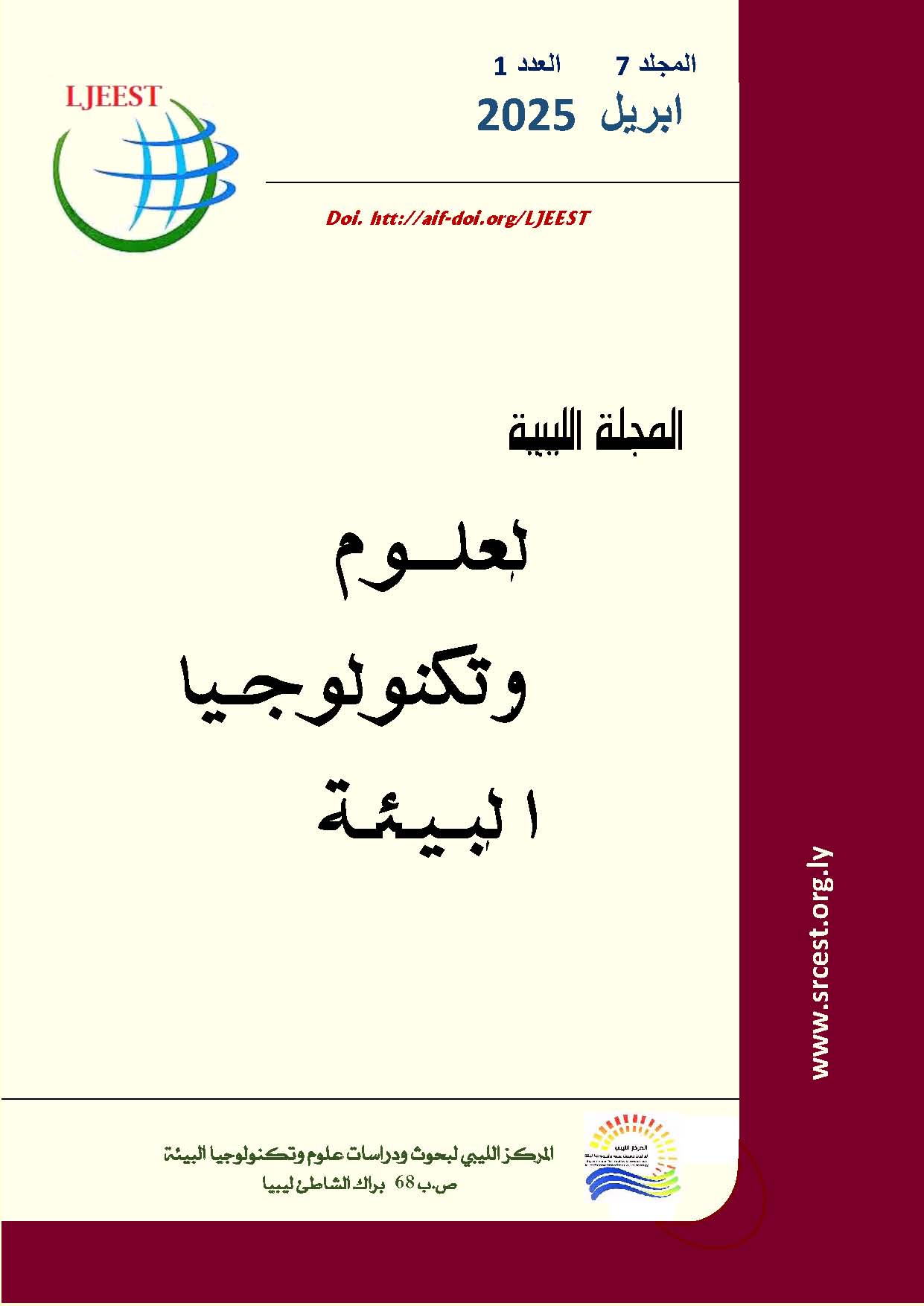تأثير أنماط الزراعة المختلفة على كمية ونشاط جنس Azotobacter في التربة
DOI:
https://doi.org/10.63359/0tsm3a41الكلمات المفتاحية:
بكتيريا الآزوتوباكتر، الوفرة، كردستان، التحليل الجزيئي، خصوبة التربةالملخص
يواجه المزارعون تحديات في زراعة المحاصيل المختلفة بسبب التأثير المستمر للتربة الجيرية على ديناميكيات الأنشطة الميكروبية. الهدف الرئيسي هو تحديد وقياس Azotobacter spp في التربة المزروعة وغير المزروعة عبر مواقع مختلفة وتحليل علاقاتها التطورية بناءً على تسلسلات جينات 16S rRNA الجزئية. تم أخذ عينات من التربة من مواقع محاصيل متنوعة وخضعت لتحليل التنوع البكتيري باستخدام طريقة أقصى احتمال. تباينت وفرة وتنوع Azotobacter بشكل كبير بين التربة المزروعة وغير المزروعة. أظهرت التربة المزروعة انتشارًا أعلى لـ Azotobacter chroococcum في جميع المواقع، بينما احتوت التربة غير المزروعة على أنواع أخرى مثل Azotobacter vinelandii و Azotobacter salinestris. أكد التحليل التطوري الروابط الوراثية الوثيقة بين Azotobacter spp. بالإضافة إلى تكتلها الفريد فيما يتعلق بأجناس أخرى مثل Bacillus و Xanthobacter. أظهرت شجرة النشوء والتطور لتسلسل الرنا الريبوسومي 16S أن الأنواع المحددة من الآزوتوباكتر وغيرها من الأصناف المثبتة للنيتروجين مثل زانثوباكتر، وسودوموناس، وكلبسيلا، لها روابط تطورية وثيقة. وأظهرت النتائج أيضًا أن تحسين تثبيت النيتروجين وخصائص تبادل الكاتيون كانت مؤشرات على زيادة نشاط الآزوتوباكتر في التربة المزروعة. يشير انتشار الآزوتوباكتر في التربة المزروعة إلى قدرتها على التكيف في الأراضي الزراعية. وخلصت الدراسة إلى أن ممارسات الزراعة تؤثر بشكل كبير على تجمعات الآزوتوباكتر، مما يفضل الأنواع ذات الكفاءة العالية في تثبيت النيتروجين. يمكن أن يؤدي تعزيز نشاط الآزوتوباكتر في التربة إلى تحسين توفر النيتروجين وخصوبة التربة. يوصى بتبني تناوب المحاصيل والتعديلات العضوية وتقليل استخدام الأسمدة الكيماوية لدعم تجمعات الآزوتوباكتر والحفاظ على صحة التربة. وبالتالي، يُنصح المزارعين والباحثين في منطقة كردستان في أربيل باستخدام الأسمدة الحيوية القائمة على الآزوتوباكتر على التربة الجيرية لزيادة خصوبة التربة والنشاط الميكروبي.
المراجع
Aasfar, A., Bargaz, A., Yaakoubi, K., Hilali, A., Bennis, I., Zeroual, Y., & Meftah Kadmiri, I. (2021). Nitrogen fixing Azotobacter species as potential soil biological enhancers for crop nutrition and yield stability. Frontiers in microbiology, 12, 628379.
Altschul, S. F., Madden, T. L., Schäffer, A. A., Zhang, J., Zhang, Z., Miller, W., & Lipman, D. J. (1997). Gapped BLAST and PSI-BLAST: a new generation of protein database search programs. Nucleic acids research, 25(17), 3389-3402.
Atlas, R. M. (2010). Handbook of Microbiological Media (4th ed.). CRC Press.
Datsko, O., Kovalenko, V., Yatsenko, V., Sakhoshko, M., Hotvianska, A., Solohub, I., ... & Tkachenko, R. (2024). Increasing soil fertility as a factor in the sustainability of agriculture and resilience to climate change. Modern Phytomorphology, 18, 110-113.
de Lima, J. D., de Souza, A. J., Nunes, A. L. P., Rivadavea, W. R., Zaro, G. C., & da Silva, G. J. (2024). Expanding agricultural potential through biological nitrogen fixation: Recent advances and diversity of diazotrophic bacteria. Australian Journal of Crop Science, 18(6), 324-333.
Dou, X., Zhang, C., Chen, L., Wu, Q., Zhou, G., Ma, D., ... & Zhang, J. (2024). Calcium forms influence soil organic carbon by mediating labile organic carbon fractions, carbon pool management indices and microbial communities in calcareous alkaline soils. Plant and Soil, 1-17.
Glick, B. R. (2012). Plant Growth-Promoting Bacteria: Mechanisms and Applications. Scientia Horticulturae, 144, 51–57.
Gothandapani, S., Sekar, S., & Padaria, J. C. (2017). Azotobacter chroococcum: Utilization and potential use for agricultural crop production: An overview. Int. J. Adv. Res. Biol. Sci, 4(3), 35-42.
Guo, H., Hu, Z., Zhang, H., Hou, Z., & Min, W. (2019). Soil microbial metabolic activity and community structure in drip-irrigated calcareous soil as affected by irrigation water salinity. Water, Air, & Soil Pollution, 230, 1-12.
Jnawali, A. D., Ojha, R. B., & Marahatta, S. (2015). Role of Azotobacter in soil fertility and sustainability–a review. Adv. Plants Agric. Res, 2(6), 1-5.
Kasiviswanathan, S. C. B., Duraisamy, S., Thiyagarajan, C., Subramanium, T., Dananjeyan, B., Thiruvenkatasamy, S., ... & Palani, R. (2024). Enzymatic alterations of soil and plant system on applied Zn sources, organics and microbial inoculants in zinc deficient calcareous and non-calcareous soils. Journal of Plant Nutrition, 47(11), 1850-1866.
Kaur, S., Kalia, A., & Sharma, S. (2024). Bioformulation of Azotobacter and Streptomyces for Improved Growth and Yield of Wheat (Triticum aestivum L.): A Field Study. Journal of Plant Growth Regulation, 1-17.
Kumar, P., & Dubey, R. C. (2016). Plant Growth-Promoting Rhizobacteria and Their Role in Alleviating Soil Stress. Springer Handbook of Environmental Chemistry, 94, 145–168.
Mahmood, A., et al. (2020). Azotobacter as Biofertilizer: A Step Toward Sustainable Agriculture. Journal of Applied Microbiology, 129(2), 507–519.
Moeinnamini, A., Weisany, W., Hadi, M. R. H. S., Torkashvand, A. M., & Mohammadinejad, A. (2024). Enhancing Photosynthesis Pigment, Protein Content, Nutrient Uptake and Yield in Maize (Zea mays L.) Cultivars Using Vermicompost, Livestock Manure and Azotobacter chroococcum. Journal of Soil Science and Plant Nutrition, 1-11.
Panhwar, Q.A., Ali, A. & Depar, N. (2024). Influence of various organic nutrient sources on microbial abundance, growth and yield of rice (Oryza sativa L.) under field conditions. Mehran University Research Journal of Engineering and Technology, 43(4), 69-81.
Rashid, M. I., et al. (2019). Microbial-Mediated Mitigation of Soil Alkalinity in Calcareous Soils: Mechanisms and Applications. Applied Soil Ecology, 139, 71–83.
Shahwar, D., Mushtaq, Z., Mushtaq, H., Alqarawi, A. A., Park, Y., Alshahrani, T. S., & Faizan, S. (2023). Role of microbial inoculants as bio fertilizers for improving crop productivity: A review. Heliyon, 9(6).
Singh, S., et al. (2018). Role of Azotobacter in Soil Fertility and Sustainability. Journal of Soil Science and Plant Nutrition, 18(3), 683–694.
Tripathi, M. K., Shukla, S. K., Jaiswal, V. P., Sharma, L., Nagargade, M., Pathak, A. D., ... & Ranka, A. (2024). Integration of Mycorrhizae, Azotobacter and Pseudomonas spp (PSB) with NPK and their Effects on Sugarcane Crop and Soil Health in Uttar Pradesh, India. Sugar Tech, 1-17.
Yadav, B. K., et al. (2021). Enhancing Productivity in Calcareous Soils Using Biofertilizers: A Review. Frontiers in Soil Science, 2, 39.
Yilihamu, A., Ouyang, B., Ouyang, P., Bai, Y., Zhang, Q., Shi, M., ... & Yang, S. T. (2020). Interaction between graphene oxide and nitrogen-fixing bacterium Azotobacter chroococcum: transformation, toxicity and nitrogen fixation. Carbon, 160, 5-13.
Zaidi, A., et al. (2017). Role of Azotobacter in Improving Soil Quality and Crop Yield. Microbial Strategies for Crop Improvement, 22, 145–159.















